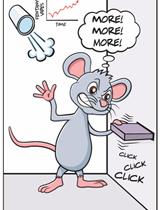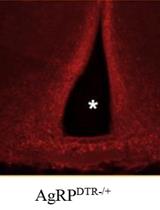- EN - English
- CN - 中文
Shock-probe Defensive Burying Test to Measure Active versus Passive Coping Style in Response to an Aversive Stimulus in Rats
冲击探测防御性埋藏实验测定大鼠响应厌恶性刺激的积极或消极应对方式
发布: 2018年09月05日第8卷第17期 DOI: 10.21769/BioProtoc.2998 浏览次数: 6452
评审: Lara HwaKaren N KrukowskiAnonymous reviewer(s)
Abstract
Maladaptive avoidance behaviors are seen in many stress-related psychiatric illnesses. Patients with these illnesses favor passive, avoidant coping strategies rather than adaptive, active coping strategies. Preclinically, coping strategy can be measured in rats using the shock-probe defensive burying test, wherein rats receive a shock from an electrified probe inserted into a test cage that mimics their home cage environment, and behavioral output (immobility or burying) is recorded for 15 min following the shock. Immobility in response to the perceived threat of the shock-probe, associated with elevated stress hormone levels, is regarded as a passive, maladaptive coping strategy. In opposition, burying the probe is associated with lower stress hormone levels and is considered an active, adaptive coping style. In rats, chronic stress induces a shift from active to passive coping in this test (i.e., proportionally less burying and more immobility), modeling the avoidant symptoms presented across many stress-related psychiatric illnesses. The stress-induced shifts in coping style and overall behavioral reactivity to the shock-probe provide a unique and well-validated measure of not only an anxiety-like behavioral response but also coping strategy selection in rat models of psychiatric illness.
Keywords: Active coping (积极应对方式)Background
In addition to the “fight, flight, or freeze” response, rats were reported to engage in a specific defensive behavior in response to an aversive stimulus by Hudson in 1950, termed “defensive burying”. This burying behavior was determined to be an innate response of rodents (including rats, mice, hamsters, and ground squirrels) to threats in their burrows (see De Boer and Koolhaas, 2003). Additionally, it was found that rats that are allowed to bury a shock-associated stimulus have less HPA axis activation than rats who were prevented from burying and forced to adopt a passive (immobile) response, suggesting that defensive burying is more adaptive compared with passive responses (De Boer et al., 1990; Korte et al., 1992; Bondi et al., 2007). Originally described by Pinel and Treit in 1978, we have adopted the shock-probe defensive burying test in our lab to model central components of stress-related psychiatric illness, i.e., preference for passive, avoidant coping strategies versus adaptive, active coping strategies. Using the protocol described here, we have shown that chronic unpredictable stress induces a shift from active to passive coping in adult Sprague-Dawley rats in this test (Jett et al., 2015; Hatherall et al., 2017; Fucich et al., 2016 and 2018), modeling the maladaptive, avoidant coping strategies adopted by patients across many stress-related psychiatric illnesses (Koolhaas et al., 1999; Bondi et al., 2007). We have previously described the validity of this test as a measure of anxiety-like responding (see Lapiz-Bluhm et al., 2008), and have more recently shown the efficacy of novel antidepressant drugs as well as behavioral therapy in reversing chronic stress-induced shifts in coping style choice (Jett et al., 2015; Hatherall et al., 2017; Fucich et al., 2016 and 2018). Thus, measuring coping style and aversive stimulus reactivity with the shock-probe defensive burying test in rats is useful in characterizing animal models of stress-related psychiatric illnesses like depression and posttraumatic stress disorder as well as testing novel therapeutic interventions and their mechanisms. Variations of the shock-probe defensive burying test have been used to test mice (e.g., Sluyter et al., 1996 and 1999; López-Rubalcava et al., 2000; Paez-Martinez et al., 2003) as well as various rat strains (as reviewed in De Boer et al., 2003), therefore the protocol described here may feasibly be adapted to any rodent model which displays innate defensive burying.
Materials and Reagents
- Certified Sani Chips, identical to rat’s home cage bedding material (Envigo, Harlan, Teklad, catalog number: 7090C )
- Polyethylene tubing, PE-50 (Scientific Commodities, catalog number: BB31695-PE/1 )
- Industrial grade adhesive (SP Scienceware - Bel-Art Products - H-B Instrument, catalog number: 24006-0000 )
- Abrasive sanding sheets (3MTM WetordryTM Abrasive Sheets, aluminum oxide, grade P400) (3M, catalog number: 213Q )
- Paper towels
- Numbered index cards to identify animals for blind scoring
- Masking tape
- Permanent marker
- Rat (Sprague-Dawley)
- Distilled water
- 10% ethanol
Equipment
- Plastic “shoebox” rat cage with plastic barrier lid (ours are 42 cm x 20 cm x 20 cm, identical to our home cages; e.g., Allentown, catalog number: PC10198 )
- Uninsulated copper wiring, 1 mm diameter (Fisher Scientific, catalog number: 15-545-1B)
Manufacturer: Arcor Electronics, catalog number: BARE18GA . - Glass stirring rods, 5 mm diameter x 200 mm length (Fisher Scientific, catalog number: S63449 )
- Ring stand (EISCO, catalog number: CH0653E1RD4 )
- Three prong extension clamp (Fisher Scientific, catalog number: 05-769-7Q ), attached to ring stand
- Alligator clips (EISCO, catalog number: PH1053B ), cut and soldered, one to each lead of the shock output cable for the shock generator
- Uninsulated wire-wrapped shock probe (Custom fabrication, see Step A1 of Procedure)
- Modified test cage and lid (Custom fabrication, see Step A2 of Procedure)
- Electric drill
- Utility knife
- Wire cutters
- Shock generator (e.g., Coulbourn Instruments, model: H13-15 )
- Video camera
- Tripod
- Computer
- Timer
Software
- Video recording software, e.g., QuickTime (Apple)
- Statistical analysis software, e.g., Statistica (TIBCO Software)
Procedure
文章信息
版权信息
© 2018 The Authors; exclusive licensee Bio-protocol LLC.
如何引用
Readers should cite both the Bio-protocol article and the original research article where this protocol was used:
- Fucich, E. A. and Morilak, D. A. (2018). Shock-probe Defensive Burying Test to Measure Active versus Passive Coping Style in Response to an Aversive Stimulus in Rats. Bio-protocol 8(17): e2998. DOI: 10.21769/BioProtoc.2998.
- Fucich, E. A., Paredes, D., Saunders, M. O. and Morilak, D. A. (2018). Activity in the ventral medial prefrontal cortex is necessary for the therapeutic effects of extinction in rats. J Neurosci 38(6): 1408-1417.
分类
神经科学 > 行为神经科学 > 实验动物模型 > 小鼠
神经科学 > 行为神经科学 > 应对
您对这篇实验方法有问题吗?
在此处发布您的问题,我们将邀请本文作者来回答。同时,我们会将您的问题发布到Bio-protocol Exchange,以便寻求社区成员的帮助。
提问指南
+ 问题描述
写下详细的问题描述,包括所有有助于他人回答您问题的信息(例如实验过程、条件和相关图像等)。
Share
Bluesky
X
Copy link












